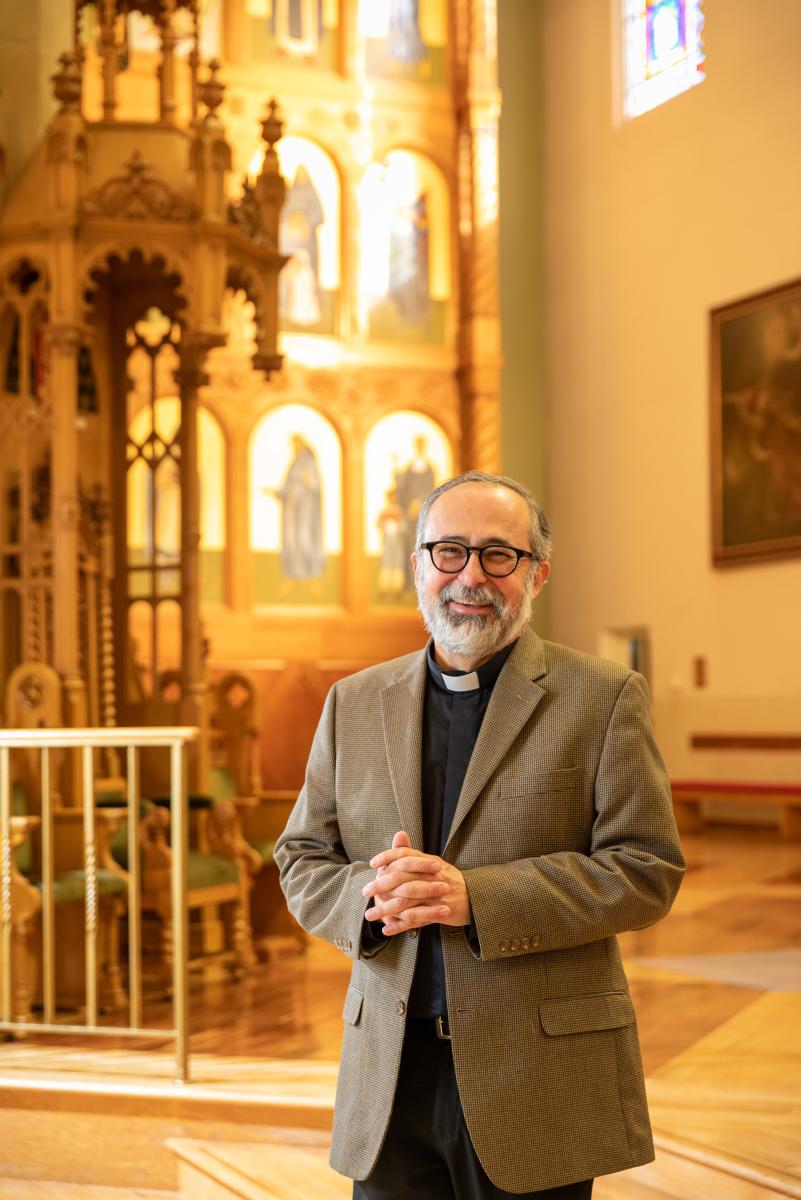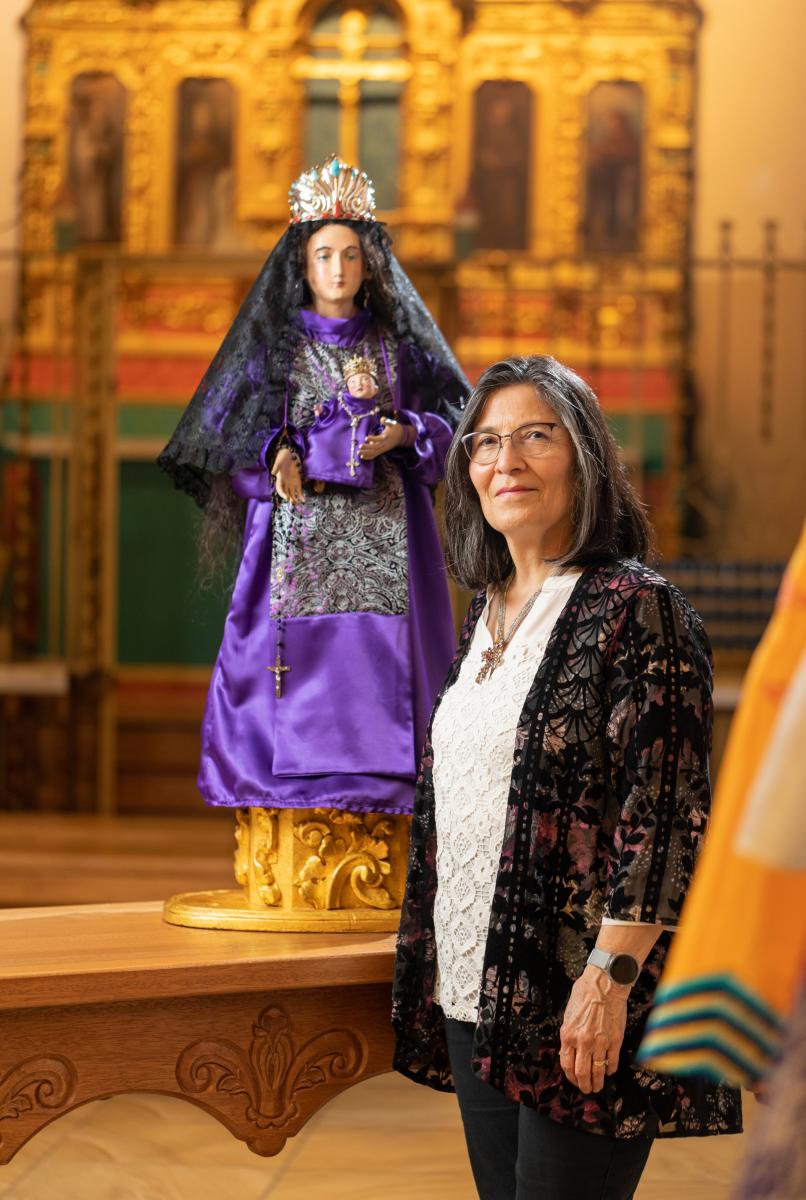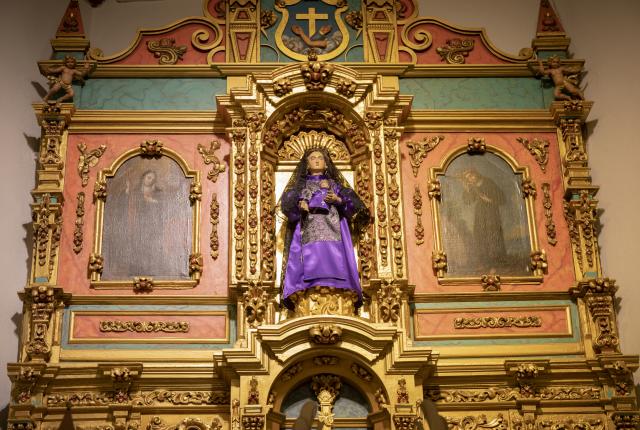Our Lady of Peace is on view at the Cathedral Basilica of St. Francis of Assisi, in Santa Fe.
WHENEVER HE RECEIVES A NEW PARISH assignment, the Reverend Timothy Martinez searches for his family ties. He studies the history of the area, including parish records, and has done so at St. Gertrude the Great Catholic Church, in Mora, and then San Francisco de Asís, in Ranchos de Taos. Nearly always, he finds parts of himself.
“Genealogy is how I learned history,” he says.
In 2019, Martinez became rector of the mother church of Roman Catholicism in the Southwest—the Cathedral Basilica of St. Francis of Assisi, in Santa Fe. There, his search led him to a small statue of the Virgin Mary. The oldest Madonna in the United States, she holds a place of honor in a side chapel within the cathedral, where she has been enshrined almost continuously for nearly 400 years. She might be even older. Tree-ring dates reveal the figure could have been carved as early as 1448, from what is likely an olive tree’s wood.
In learning her history, Martinez read Fray Angélico Chávez’s classic book La Conquistadora: The Autobiography of an Ancient Statue. Told from Mary’s perspective, it describes her probable origins in Spain, an ocean journey to Mexico, and the 1,500-mile overland trek in an oxcart to Santa Fe, arriving in January 1626.
During the 1680 Pueblo Revolt, the statue was stranded inside a burning church. Josefa López Sambrano de Grijalva, a young woman who held the position of sacristana—the person charged with caring for the statue—raced in and snatched it from destruction. Reading about her in the Chávez book, Martinez recognized names from his research. “Eleven generations back, Josefa is my grandmother,” he says. “I’m not proud of everybody that’s in my family line; some of them did terrible things. But I’m certainly proud of Josefa.”
Over the centuries, the statue has been called Our Lady of the Assumption, Our Lady of the Immaculate Conception, Our Lady of the Rosary, and, most famously, La Conquistadora, a symbol of the Spanish reconquest of Santa Fe in 1692. In 1992, former archbishop Robert Sanchez renamed her Nuestra Señora de la Paz—Our Lady of Peace—as a gesture of reconciliation with the Native community.
For Martinez, she symbolizes the overwhelming love of a mother. “We can talk about the statue, but we need to remember the person behind it, the person it represents: Mary,” he says. “She is reminding us we live in hope. We have the emotion of being afraid. She’s calling us not to make choices out of fear, but to make choices out of love.”

Whenever Reverend Timothy Martinez receives a new parish assignment, he searches for his family ties.
VENERATED BY BELIEVERS AS LA PATRONA, OR THE PATRONESS, of Santa Fe, Our Lady’s renown reaches beyond the city. Even New Mexicans who lack the ability to drop in at the cathedral basilica, light a candle, and pray in her chapel revere her. Many commission dresses to be made for her, often in thanksgiving or in memory of a loved one. She has one of the best closets in Santa Fe, set in a room within the cathedral, its walls lined with kitchen-like cupboards. Arrayed on small hangers, more than 300 handcrafted outfits gleam in brocade, silk, velvet, and other fine fabrics. The Museum of Spanish Colonial Art was sufficiently impressed to mount an exhibit of them in 2010.
She has capes, mantillas, rosaries, and other accessories—pearls, jewels, and crowns, including a gold crown given to her in 1960 at her papal coronation. The people of Holy Cross, Alaska, made an ermine cape for her, asking only for prayers in return. Her wigs are of human hair from people who donate their locks.
In 1973, two teenagers kidnapped her and held her for ransom. Parishioners felt as if a family member had been taken. But their prayers were answered. The culprits were caught, and Mary was found in an abandoned mine shaft near Los Lunas.
Marissa Swazo-Hinds, who grew up at Tesuque Pueblo practicing her Native and Catholic religions, served as an Indian princesa on the queen’s court during the 2015 Fiesta de Santa Fe. The commemoration, held each September, marks the return of Spanish settlers to New Mexico and features religious events, concerts, parades, a street fair, and the burning of Zozobra, a giant marionette also known as Old Man Gloom.
 Tools for quick sewing repairs (left) and a Native-style dress with a Pendleton blanket for the baby Jesus (right) are available for Our Lady of Peace.
Tools for quick sewing repairs (left) and a Native-style dress with a Pendleton blanket for the baby Jesus (right) are available for Our Lady of Peace.
“That’s where my devotion became stronger,” Swazo-Hinds says. “That’s when I found out she didn’t have many garments that were Native American.”
For the past six years, Swazo-Hinds has helped to fill that gap. Three Christmases ago, she designed an outfit with pieces of mink fur around the collar of a shawl and gave the baby Jesus that Mary sometimes carries a tiny Pendleton swaddling blanket. “She looked really regal,” Swazo-Hinds remembers.
As she works on her dresses, Swazo-Hinds asks Our Lady for assistance. “Guide my hands, my eyes,” she says. “I ask her to keep myself and my family in good health and good spirits.” She says broader prayers, too, for community members to respect and love one another. “The last two or three outfits have been just a prayer that we’ll always have peace, that we’ll keep Native ways strong.”
In recent years, Indigenous people and their allies have protested parts of Fiesta, especially those decried as a celebration of Spanish domination over the tribes. Swazo-Hinds was part of Fiesta when the protests began to grow louder. It bothered her, given her upbringing.
“Growing up,” she says, “my grandparents, we always went to church, we always lived our Catholic way as well as our Native way. It was never one is better than the other. It was always equal.”
For her, Our Lady of Peace is a symbol of reconciliation. “There was bloodshed on both sides,” she says. “We all lost certain things at that time. But we came back to reunite. That’s how we live today. People are married with Hispanics, we’re all intermingled in today’s society. That’s what we need to remember.”

Terry Garcia is the caretaker of Our Lady of Peace.
YEARLY, THE DEVOUT TAKE OUR LADY OF PEACE FROM THE CATHEDRAL basilica and carry her in a blocks-long procession to Rosario Chapel. About a mile west, it was built in 1807 on the site where Don Diego de Vargas is believed to have camped when he came to retake Santa Fe.
In a tradition dating to 1712, the faithful attend a series of nine Masses—usually in June or July, depending on the church calendar—in gratitude for Mary’s intercession to help them return home. Then Our Lady returns to the cathedral. In 2020, because of covid, the novena Masses were livestreamed. Still, the faithful watched and prayed.
Terry Garcia, current sacristana for Our Lady, grew up in Clovis but often visited Santa Fe with family. They didn’t take in the sights, even to visit La Conquistadora, as she was then known. “The cathedral was so foreign to me, it could have been 500 miles away,” Garcia says.
The children played, the adults talked, and on Sundays they all went to Our Lady of Guadalupe Church, her aunt’s parish. But part of playtime involved running in and around arroyos. From the one by her aunt’s house, little Terry could see a small church in the distance: Rosario Chapel.
“I was so curious,” Garcia says. “Why didn’t we go to that chapel? Why did we go to Guadalupe?” Her aunt explained what went on at the rarely used chapel, set toward the back of Rosario Cemetery. “See that street there?” she told her niece. “They come in procession and bring Our Lady and they leave her for a week.”
Read More: The Chimayó Museum does more than preserve artifacts. It’s saving a community.
Those processions represent a promise. After the Pueblo Revolt, when the area’s tribes plotted an uprising against the Europeans’ cruelty, the Spanish colonists fled to exile in the El Paso area, taking their beloved statue with them. For more than a decade, they dreamed of returning to what they considered home.
In 1692, Vargas, the general chosen to lead the settlers, prayed to Our Lady. He asked for her assistance, vowing that if he could retake Santa Fe peacefully, her people would remember her. The meeting between Vargas and the Pueblo leaders that year—during which the Spanish believed they reached an agreement that they could return—forms the basis for the Fiesta de Santa Fe, crafted to present the myth of a bloodless reconquest. The reality is more complicated.
If there even was an agreement in 1692 that the Spanish could come back, it did not last into 1693, when violence erupted. Eventually, Spanish and Native people came to coexist, but the wounds still run deep. After a Fiesta reenactment of the meeting between Vargas and tribal leaders drew sustained protests, it went the way of the Plains headdresses some pageant participants wore in the 1970s.

Our Lady of Peace wears a resplendent purple gown during Lent.
Throughout, Our Lady has remained a constant.
“In and through all of the different controversies we have faced over the last few years, she’s the same Holy Mary, Mother of God, our Blessed Mother,” Garcia says. “She’s the same person, manifested to us in this incredible way for the last 400 years.”
Garcia finally met her in person when she moved to Santa Fe in 1976 to attend the College of Santa Fe. A friend took her to the cathedral basilica and said, “There she is.”
“I’ve never been the same,” Garcia says. “Little did I know that from that little arroyo I would come to do what I’m doing now.”
People call Garcia to see how they can have an outfit or a wig made for her. The donors of outfits, before covid, were able to watch and pray their intentions as Garcia dressed the statue. Lately, with the cathedral basilica being mostly closed, they ask her to whisper a prayer on their behalf.
Read More: The people who saved Socorro's San Miguel Mission.
The closing of in-person Masses occurred during Lent last year. New traditions arose. On Good Friday, the staff took Our Lady of Peace outside the massive doors of the church. Clad in regal purple, she looked over her city, blessing it in this time of trouble. For the Easter broadcast, Father Tim had her placed on the altar so people watching from home could see her. For the first time, she wore a Pueblo dress for Easter, a suggestion from a staff member.
“Our Native people had suffered so much,” Garcia says, referring to the disproportionate impact of covid on tribal people.
She also wears Native clothing during Indian Market week and for one of Fiesta’s novena Masses. It serves as a reminder that she belongs to all—especially in May, the Marian month, when Catholic churches hold special devotions to her. While she came to New Mexico with invaders, this statue that once was an olive branch has evolved into something larger. “She is,” Garcia says, “everybody’s mother.”

The Visitation
For the latest information on when the Cathedral Basilica of St. Francis of Assisi is open to visitors, go to their website. An open-air labyrinth near the cathedral's entrance is always available. Before the pandemic, groups could occasionally schedule a talk about Our Lady a visit to her closet. That option might return in the future.


